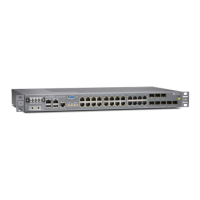17. Configure the routing instance.
This routing instance is in the Layer 2 domain where Device PE1 and Device PE2 are
interconnected to the metro ring over multiaccess media (Ethernet). You must
include the vrf-table-label statement on Device PE1 and Device PE2 to enable
advertisement of the direct subnet prefix corresponding to the logical tunnel (lt-)
interface toward the Layer 3 domain.
Device PE1 and Device PE2 use OSPF for Layer 3 VPN communication with Device
CE1.
[edit routing-instances l3vpn]
user@PE1# set instance-type vrf
user@PE1# set interface lt-1/2/0.601
user@PE1# set interface lo0.1
user@PE1# set route-distinguisher 192.168.1.101:64511
user@PE1# set vrf-import l3vpn_import
user@PE1# set vrf-export l3vpn_export
user@PE1# set vrf-table-label
user@PE1# set protocols ospf export ospf_export
user@PE1# set protocols ospf area 0.0.0.0 interface lt-1/2/0.601
user@PE1# set protocols ospf area 0.0.0.0 interface lo0.1
18. Configure the autonomous system (AS) ID and router ID.
[edit routing-options]
user@PE1# set router-id 192.168.0.101
user@PE1# set autonomous-system 64511
Similarly, configure Device PE2.
Results From configuration mode, confirm your configuration by entering the show interfaces,
show firewall, show protocols, show policy-options, show routing-options, and show
routing-instances commands. If the output does not display the intended configuration,
repeat the instructions in this example to correct the configuration.
Device A1 user@A1# show interfaces
ge-1/3/0 {
unit 0 {
family inet {
address 10.20.0.100/24;
}
family iso;
family mpls;
}
}
ge-1/3/1 {
unit 0 {
family inet {
address 10.10.0.100/24;
}
family iso;
family mpls;
}
Copyright © 2017, Juniper Networks, Inc.640
ACX Series Universal Access Router Configuration Guide

